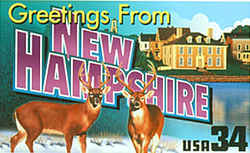New Hampshire Early History
First Early Inhabitants of New Hampshire

Early history examines the archaeological record that tells the story of the first inhabitants of New Hampshire. Learn about the prehistory and culture of the first early inhabitants, and what lessons it might teach us about the early history of New Hampshire.
New Hampshire First Early Inhabitants Timeline
- 12,000 years before present (BP) until 9,000 BP. During this era,
small nomadic hunting groups using spears to hunt caribou and mammoth in the tundra. In other parts of the country, Paleoindian groups hunted larger
Pleistocene mammals such as mastodon or mammoth. In New England there is no evidence that these mammals were utilized by humans as a food source. People moved into New England after deglaciation of the region concluded around 14,000 BP. Radiocarbon dates place the first people in New England at 10,000 BP. As the ice retreated northwards, a harsh and unforgiving environment resulted. The people who subsisted in the cold tundra were hardy by necessity. Since resources were found in patches across the landscape, only small mobile groups could survive. Archaeological evidence dating to the Paleoindian period is found in New England - Archaic Period (9,000-3,000 BP) During the Archaic Period, humans adapted to an evolving temperate forest, which flourished after
a warming trend in New England. These groups had access to a wide range of
resources including deer, an important dietary staple. - 9,000 YBP EARLY MIDDLE ARCHAIC Hunter/gatherers using seasonal camping sites for several months duration to hunt deer, turkey, and fish with spears as well as gathering plants.
- 6,000 YBP LATE ARCHAIC Larger base camps; small groups move seasonally through mixed-oak forest, including some tropical plants. Abundant fish and game; seeds and nuts.
- 7000 - 1000 BC - Archaic Period; Native Americans move seasonally around New Hampshire to live, hunt, gather, and fish
- 3,000 YBP WOODLAND Semi-permanent villages in which cultivated food crops are stored. Mixed-oak forest, chestnut. Slash and burn agriculture changes appearance of landscape. Cultivated plants: corn, beans, and squash. Bows and arrows, spears used along with more wood, bone tools.
- 1000 BC - 1600 AD - Woodland Period; Native Americans establish villages and develop trade networks, and ceramic and bow and arrow technology
- 1602 - Bartholomew Gosnold (1572 - 1607) explores coast
1638 - The New Hampshire Colony was founded by John Mason and established by John Wheelwright and others - 1688
- 1688 - 1763 The French and Indian Wars between France and Great Britain for lands in North America consisting of King William's War (1688-1699), Queen Anne's War (1702-1713), King George's War (1744 - 1748) and the French and Indian War aka the Seven Years War (1754-1763)
- (1688-1699) King William's War (part of the French and Indian Wars) between France and the Wabanaki Confederacy and England and the Iroquois Confederacy. Peace Treaty made at Pemaquid. August 11,1693. and was ratified on Jan. 7. 1699
- 1702 - (1702 - 1713) Queen Anne's War (part of the French and Indian Wars) between the French and Spanish colonies allied with the Wabanaki Confederacy, Mohawk, Choctaw, Timucua, Apalachee and Natchez tribes against the British colonies allied with the Muscogee (Creek), Chickasaw and Yamasee tribes.
- 1744 - (1744 - 1748) King George's War (part of the French and Indian Wars) between the French colonies allied with the Wabanaki Confederacy and the British colonies allied with Iroquois Confederacy
- 1754 - (1754 - 1763) The French Indian War is won by Great Britain against the French so ending the series of conflicts known as the French and Indian Wars
Early History of Native Americans in New Hampshire
The Indigenous People of New Hampshire
The names of the New Hampshire tribes included the Abenaki, Malecite, Passamaquoddy and Pennacook.
Archaeologists believe the first humans came to the area now known as New Hampshire around 10,000 years ago after the glaciers receded and the climate
warmed. These tribes became more settled and less nomadic as time went on. Because of climate and length of growing season, tribes in the north of
New Hampshire probably engaged in more hunting while tribes in the south engaged in relatively more agriculture, although agriculture probably never
had the importance in early New Hampshire that it had further south in what we now call Massachusetts.
The Abenaki and Pennacook Indians were living in the area of New Hampshire when Europeans arrived. It is unknown who the first white men to explore
the area were, but general exploration began in the 1600s. Europeans came to New Hampshire for economic reasons, looking to exploit the resources of
the area, especially forests, furs, and fish.
In 1603, the Englishman Martin Pring explored the mouth of the Piscataqua River. John Smith explored the Isles of Shoals in 1614, naming them Smith's
Islands.
European diseases brought to the New World by early settlers may have killed as many as 95% of the natives in the area of New Hampshire. Those remaining
retreated to Vermont and Canada under pressure from English settlers.








